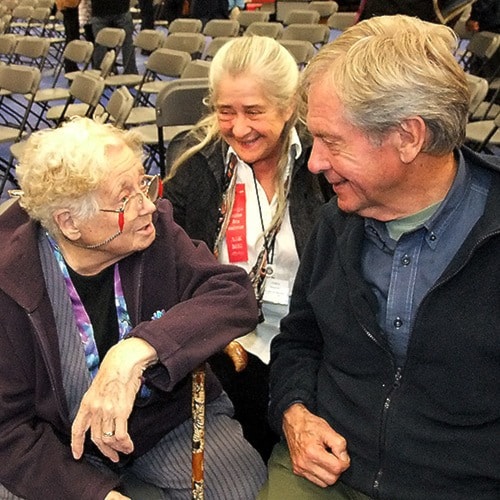The average North American child spends 7 1/2 hours a day in front of a screen and zero hours outside in Nature, according to Robert Bateman.
The well-known Canadian wildlife artist was in Clearwater last weekend to take part in a sod-turning ceremony for Thompson Rivers University’s proposed TRU Wilderness Center near Wells Gray Park.
Friday evening he gave a talk at Clearwater Secondary School on how to re-connect young people with Nature. Nearly 250 people attended his talk – a Wells Gray World Heritage Year event.
“I never heard of a soccer mom when I was growing up,” said Bateman. “We got a ball, we went into a field, we played soccer. No adult needed to supervise.”
Today, many mothers are afraid to let their children go outside into Nature.
“Kids are smart,” the artist said. “If they see a cliff or a fire, they’ll be careful.”
Since the 1950s parents have become more and more reliant on television and then computers to “babysit” their children, Bateman said.
The result is that a significant number of today’s young people will die before their parents because of their inactive lifestyles.
No child should be allowed to watch television before he or she is at least three years old, he said.
He described video games as “junk food for the soul.” They are very damaging to the brains of teens, according to Bateman.
People are designed to live with Nature, he said. Hospital patients who can see trees outside their windows heal quicker than those who cannot. A program in Japan that takes Tokyo office workers for a one-hour walk through nearby parks results in lowered blood pressure readings and other benefits.
To help bring young people back to Nature, Bateman is helping to set up the Robert Bateman Center in the Inner Harbor at Victoria.
The center, which is to be located in the former wax museum, will have an interactive display of about 120 of his paintings on the first floor.
The second floor will have offices and meeting rooms where people will attempt to coordinate various nature programs.
“I have a confession to make. I just paint and rant,” Bateman said.
Now world famous for his wildlife art, he at one time painted only abstract paintings.
“People look at an abstract painting and ask, ‘What’s it a painting of?’” he said. “You don’t look at a Persian carpet and ask, ‘What’s it a Persian carpet of?’ Why would you ask that about a painting?”
Bateman said he still admires and is influenced by abstract art, and showed a couple of examples in his powerpoint demonstration.
Although he teaches art classes himself, people don’t really need to go to art school to become artists. All they really need is to spend time painting, he said.
During the evening it was announced that the person who had the family version of the Wells Gray World Heritage Year treasure hunt had declined to accept the $1,000 prize. Instead, it will be used as a prize in a treasure hunt to be held next year.
The $1,000 prize for the more ambitious version of the treasure hunt remains unclaimed.
Wells Gray Country services committee will look at sponsoring the treasure hunt a second time, said TNRD director Tim Pennell.
Below: Winners of door prizes at a talk by Robert Bateman on Friday evening at Clearwater Secondary School show off their winnings. Pictured are (l-r) Mary Porter, Zara Bieber, Robert Bateman and Bill Merilees. Porter is from Chase and has attended many Wells Gray World Heritage Year events. Nanaimo resident Merilees was a lead presenter at Yorke Edwards Day in Upper Clearwater Hall on Saturday

